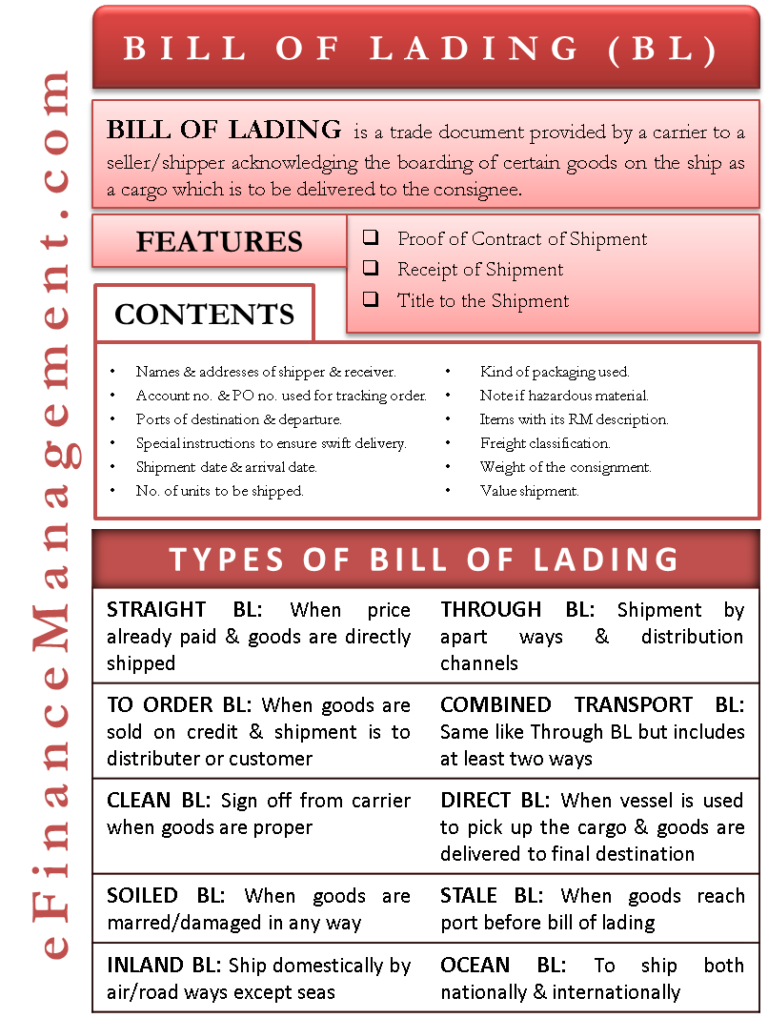Bill of Lading BOL Guide: Types, Uses & Template
Table Of Content

If your shipment is LTL, then you'll also need the freight class of the shipment. At the absolute minimum, these things must be notated on the BOL or else the freight probably won't be picked up and you could get charged a dry run by the carrier. Receive news and insights that help you navigate supply chains, understand industry trends, and shape your logistics strategy. After a booking is placed with a carrier, the shipper needs to submit Shipping Instructions with accurate information about the shipment, which the carrier uses to create a bill of lading.
Most Popular Documents
Usually, all companies that sell transportation services generate bills of lading. They can include owner-drivers, freight forwarders, steamship lines, third-party logistics companies and others. They include companies transporting goods by any means, whether it be through air, sea, rail or road.
How to Make a Bill of Lading & BOL Template
Additionally, you can customize the output of the extracted tables. The automated tool lets you set up predefined rules & formats to check whether details like names, addresses, and product descriptions are accurate. Additionally, you can even consider and re-assess the risk factors involved in your shipment.
A ship broker presentation lured me in, Henrik Hansen, AAL Shipping - Project Cargo Journal
A ship broker presentation lured me in, Henrik Hansen, AAL Shipping.
Posted: Tue, 07 Feb 2023 08:00:00 GMT [source]
Trucking Bill of Lading Template
It's worth a quick note here on something else you might encounter in your shipping — a telex release or electronic cargo release. The telex release is not a type of bill of lading, but a method of releasing a bill of lading electronically. A telex release is only relevant to shipments where an original bill of lading has been issued.
When shipping or receiving goods, it is critical that a B/L be part of the process. First, it acts as proof that the shipping line promised to carry the goods. Second, it acts as a “receipt” – proof that the merchandise listed was received and is in good order.
It serves as evidence of the contract of carriage, receipt of goods, and title ownership. This document is crucial for tracking and transferring goods across multiple modes of transportation. Provide contact information for both the shipper and consignee, and then list each package (or “unit”) being shipped as a separate entry in the provided table. Be sure to check whether or not each item contains hazardous material so the shipping company can take the necessary safety precautions. A straight bill of lading is a non-negotiable document that ensures cargo is delivered solely to the designated recipient.
What a Bill of Lading Should Include
Drivers and carriers are looking to avoid violations during these inspections. There are several types of BoL, each suited for different trade scope and usage. When you place an order for goods from an international supplier, the Bill of Lading steps in as a crucial receipt.
The bill of lading (BOL) is one of the most important things you need for your freight shipping because it is the evidence of your contract with your carrier, forwarder, or freight broker. Whether you’re opting for less-than-truckload (LTL), ocean freight, or intermodal shipping, most, if not all, service providers won’t ship your freight without one. There are many different types of bills of lading, depending on where you are shipping to, what commodity you are shipping, and your needs.

When dealing with your broker or carrier, you will also encounter the freight bill, which may look similar to the BOL. Through this article you’ll learn what a BOL is, what’s in it, how to read it, as well as other aspects of the BOL that you should know about as a shipper. Why not sign up to Maersk today to explore the platform, browse routes and start booking.
A shipping bill is a customs declaration, while a Bill of Lading is a carrier’s receipt and contract for carriage, both crucial in international shipping. The BOL is essential for establishing ownership, liability, and responsibility for goods during transit, providing evidence of the carriage contract between the shipper and the consignee. Analyze time data to pinpoint where shipments get delayed (e.g., customs clearance, paperwork processing).
In this example, the owner does not issue a check to the vendor without reviewing the purchase order and the bill of lading. This step ensures that XYZ pays only for what it ordered and received. If the two documents do not match when the restaurant manager compares them, the manager will ask the vendor about the exception. A third employee reconciles the bank statement and makes company deposits. As an example, a logistics company intends to transport, via heavy truck, gasoline from a plant in Texas (shipper) to a gas station in Arizona (recipient).
Finally, with customizable workflow views and a work breakdown structure, you can track the time individual team members spend on shipping-related tasks to identify areas for improvement or recognize high performers. Create templates with ClickUp Docs to manage warehouse inventory, track stock levels, and generate reports to optimize storage and prevent stockouts for logistics operations. You can add widgets to update workflows, assign tasks within your Docs, and more.
Comments
Post a Comment